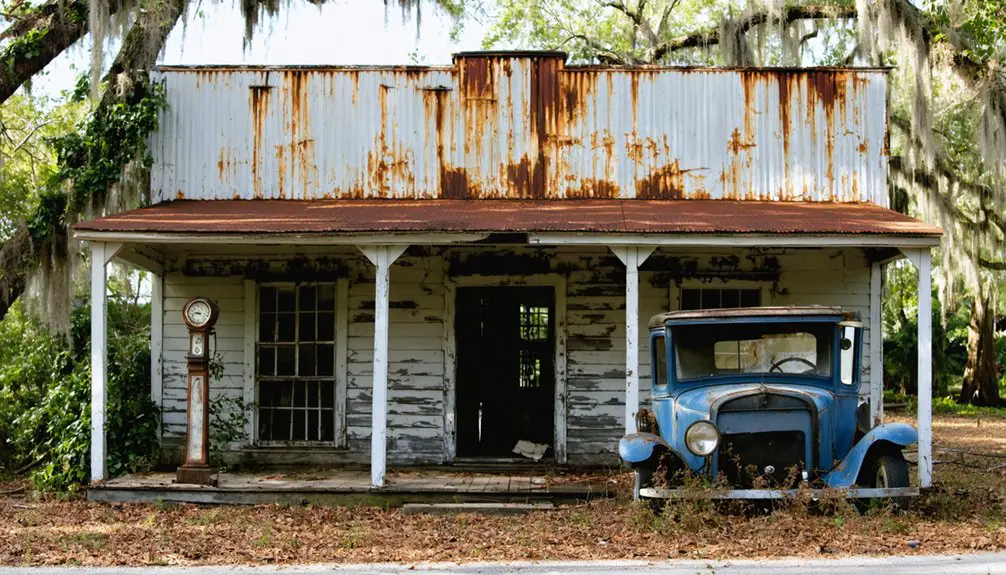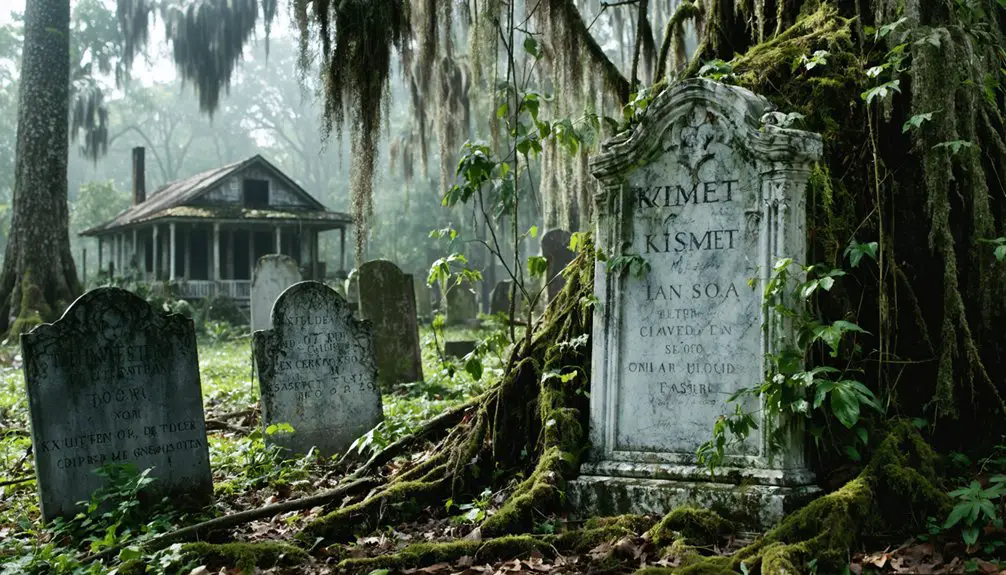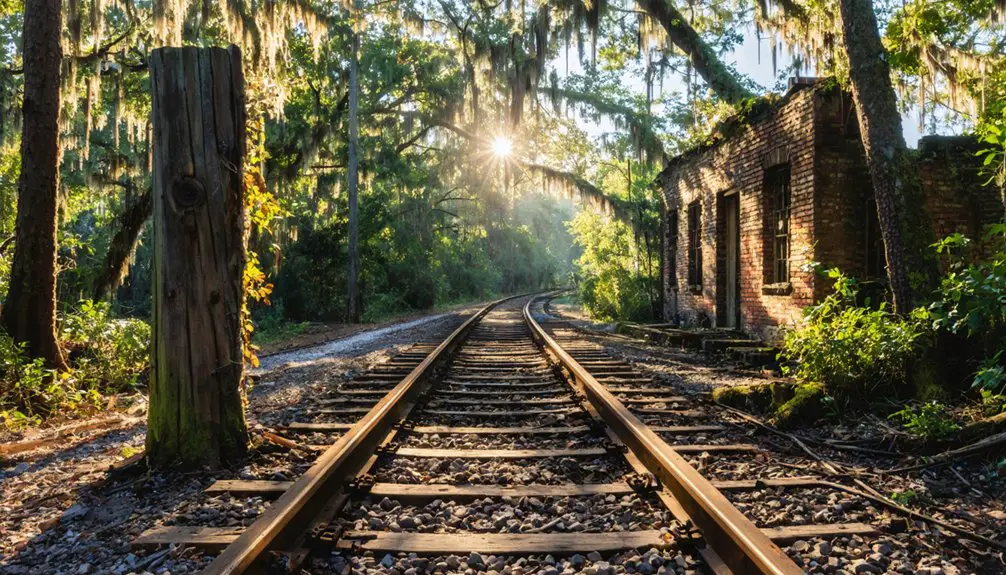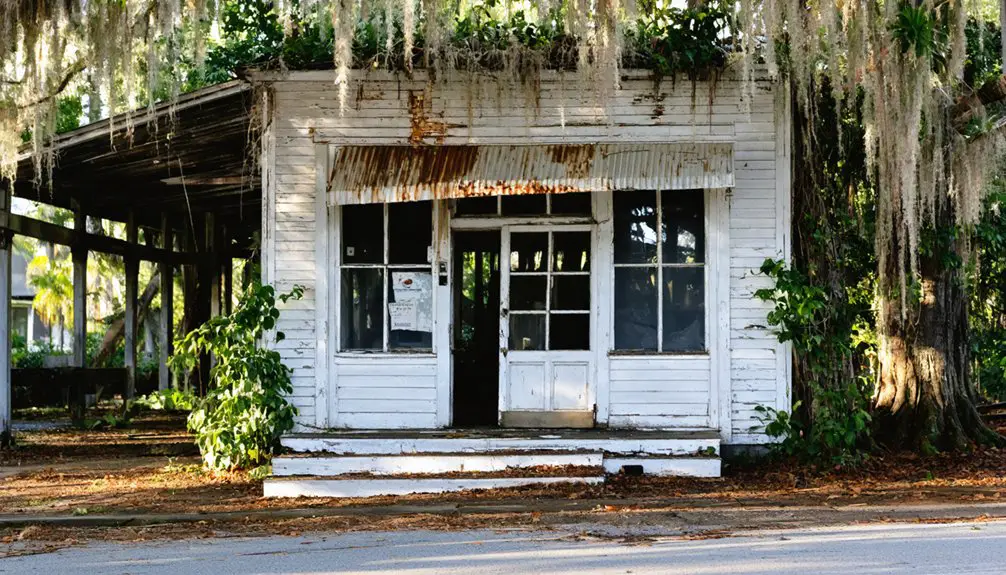You’ll find Kismet’s ruins within Florida’s Ocala National Forest, where this once-thriving citrus town emerged in the late 1880s. The settlement boasted the elegant Hotel Kismet and gained historical significance as the wedding site of Walt Disney’s parents in 1888. After the devastating Great Freeze of 1894-1895, the town’s economy collapsed, causing a mass exodus that transformed Kismet into a ghost town. Today, weathered gravestones and lost landmarks hold secrets of this forgotten agricultural frontier.
Key Takeaways
- Kismet emerged as a Florida citrus farming community in the 1880s but declined after the devastating Great Freeze of 1894-1895.
- The town’s economy collapsed when land values plummeted from $1,000 to $10 per acre, causing mass abandonment.
- Hotel Kismet served as the town’s social hub until 1910, when it was relocated to Eustis, marking Kismet’s end.
- The site now lies within Ocala National Forest, with only a historic cemetery remaining as physical evidence.
- Walt Disney’s parents, Flora Call and Elias Disney, were married in Kismet on January 1, 1888.
The Rise of a Citrus Frontier Town
As Florida’s agricultural frontier expanded in the late 19th century, Kismet emerged as one of many small towns capitalizing on the burgeoning citrus industry.
You’ll find that by the 1890s, the town had positioned itself within northeastern Florida’s thriving citrus economy, which was producing an impressive 5 million boxes of fruit annually by 1894.
The railroad’s arrival transformed Kismet from a remote outpost into a connected hub of agricultural innovation, where packinghouses and processing facilities flourished. The development of railroads enabled citrus growers to efficiently ship their produce to distant markets. Local growers utilized innovative smudge pot technology to protect their valuable citrus crops from devastating freezes.
Kismet’s transformation from isolated settlement to bustling agricultural center hinged on the railroad’s ability to connect markets and foster innovation.
You’d have witnessed the town’s rapid development as entrepreneurs, caught up in “orange fever,” invested in local groves despite previous setbacks from cold weather and disease.
The promise of prosperity attracted workers and growers alike, establishing Kismet as an essential link in Florida’s expanding agricultural network.
Early Settlement and Community Growth
You’ll find that Kismet’s early growth centered around Edward Emery Higley‘s arrival in 1883 and the subsequent formation of the Kismet Land and Improvement Company in 1884.
Understanding the multiple meanings of place name disambiguation helped historians accurately document and research this specific Florida ghost town location.
The ambitious settlement plans included establishing citrus groves and constructing the Hotel Kismet, while the St. John’s and Eustis Railroad promised essential transportation connections to wider markets.
These dreams of prosperity would face significant challenges, as the planned railroad extension never materialized, leaving the pioneering families increasingly isolated from critical trade routes.
The town gained historical significance when Flora Call married Elias Disney there on January 1, 1888, becoming the parents of Walt Disney.
Pioneering Families Arrive
During the mid-1800s, pioneering families began settling the Kismet region through land acquisitions enabled by the Armed Occupation Act of 1842 and various Spanish land grants.
These pioneer settlers established fundamental community foundations through homesteads focused on cattle ranching and essential trading infrastructure. Early settlers had to adapt to difficult conditions, as fresh water sources were limited mainly to sinkholes and limestone basins in the region. The arrival of W.W. White brought successful mercantile operations that catered to the growing settler population.
Key developments in Kismet’s early settlement included:
- Families like the Gees and Jernigans bringing substantial cattle herds and establishing critical trading posts.
- Construction of basic community structures including stores and wharfs to support growing populations.
- Formation of communication hubs through post offices, connecting isolated rural homesteads.
You’ll find that these early settlers faced considerable challenges, from regional conflicts during the Seminole Wars to environmental hardships, yet they persevered in developing crucial infrastructure that would shape Kismet’s growth throughout the 19th century.
Railroad Dreams Fade
While hopes for railroad connectivity initially fueled Kismet’s development in the 1880s, these dreams were ultimately derailed by the devastating Great Freeze of 1894-1895.
You’ll find that the St. John’s and Eustis Railroad‘s planned extension to Kismet represented the community’s railway ambitions, which aligned with the region’s citrus industry aspirations.
The economic setbacks from the Great Freeze proved insurmountable, forcing many residents to abandon their properties and dreams of agricultural prosperity.
During this period, Henry Flagler’s investments were transforming Florida’s east coast through aggressive railway expansion and luxury hotel development.
Like many Florida settlements, Kismet had counted on low land prices to attract Northern homesteaders seeking agricultural opportunities.
As Flagler’s Florida East Coast Railway expanded southward toward Miami and the Keys, Kismet’s isolation grew more pronounced.
The town’s declining fortunes were symbolized by the fate of the Hotel Kismet, which was physically relocated to Eustis in 1910, marking the end of Kismet’s hopes for railroad-driven growth.
Hotel Kismet’s Golden Era
During Hotel Kismet’s heyday, you’d find the 50-room establishment bustling with winter visitors who sought refuge from harsh northern climates.
The hotel’s social spaces and dining facilities became the epicenter of Kismet’s hospitality scene, where tourists and residents alike gathered for social events and communal activities. Similar to the Tiffany glass lamps that would later grace Orlando’s grand hotels, the establishment boasted elegant interior design features that exemplified luxury hospitality of the era. Drawing inspiration from the region’s architectural heritage, the hotel incorporated Spanish Colonial design elements throughout its facade.
You’ll find records of the hotel’s prominence lasting until 1910, when owners R.I. Collins and Dr. A.J. Hannah relocated the structure to nearby Eustis, marking the end of its golden era in Kismet.
Winter Visitors’ Social Life
As snowbirds flocked to Florida’s warmer climate, Hotel Kismet emerged as Winter Park’s premier social hub, hosting an array of sophisticated events that defined the region’s golden era.
The hotel’s vibrant social gatherings attracted everyone from local residents to visiting celebrities, creating an atmosphere where elite connections flourished naturally in the Empire Room’s piano bar and grand ballroom.
- You’d find business titans and politicians discussing deals in elegant lounges while enjoying nightly entertainment.
- You could attend extravagant themed parties featuring synchronized ballet and ice skating performances by the poolside.
- You’d experience the cultural fusion as northern sophisticates mingled with local society, shaping Winter Park’s identity through art, music, and fashion.
The hotel’s seasonal social scene established Winter Park as a distinguished winter colony destination.
Lavish Hospitality Until 1910
Beyond its role as a social nexus, Hotel Kismet stood as a tribute to Florida’s early luxury hospitality with its impressive 50-room capacity.
Under E.R. Abbott’s ownership, you’d have found lavish amenities typical of upscale late 19th-century establishments, including formal dining rooms and expansive verandas designed for discriminating guests.
The hotel’s guest experiences reflected the prosperity of Florida’s citrus era, offering sophisticated accommodations for both agricultural entrepreneurs and leisure travelers.
You would’ve witnessed the pinnacle of Kismet’s golden age until 1910, when R.I. Collins and Dr. A.J. Hannah purchased and relocated the structure to Eustis.
This move marked the end of an era, as the once-thriving hotel succumbed to the economic challenges that followed the Great Freeze.
The Disney Family Connection
Long before Walt Disney World transformed Central Florida’s landscape, the Disney family established deep roots in the region through a series of remarkable coincidences.
The Disney ancestry traced back to Norman origins led Elias Disney to Florida’s Lake County, where he’d meet his future wife Flora Call. Their wedding at Kismet’s small church marked one of the county’s first marriage licenses in 1887.
- The Call and Disney families were neighbors in Kansas before migrating to the Paisley area near Kismet around 1884.
- Elias Disney served as a horseback postman, delivering mail to over 300 families including the Calls.
- The Kismet heritage lives on through the Call family cemetery, though Elias and Flora left Florida in 1889 after crop failures and illness.
The Great Freeze and Economic Collapse

The catastrophic Great Freeze of 1894-1895 marked a turning point in Kismet’s history, occurring just years after the Disney family’s departure.
You’d have witnessed the initial December freeze damage crops while sparing most trees, but the second February freeze proved devastating as ice split citrus tree trunks and killed entire groves.
The freeze impact devastated Kismet’s agricultural economy, with land values plummeting from $1,000 to a mere $10 per acre.
The Great Freeze decimated Kismet’s farming prosperity, causing land values to collapse from $1,000 to just $10 per acre.
The economic downturn forced many local farmers into financial ruin, compelling them to abandon their properties and seek opportunities elsewhere.
This mass exodus contributed to Kismet’s eventual transformation into a ghost town, as the citrus industry shifted southward to areas less vulnerable to freezes, such as Indian River and Palm Beach County.
Abandonment and Transformation
After witnessing the devastating effects of the Great Freeze, Kismet’s metamorphosis into a ghost town accelerated through systematic dismantling and abandonment of its infrastructure.
Economic factors forced residents to relocate, leaving behind their dreams of a prosperous citrus community. The most symbolic metamorphosis came in 1910 when workers disassembled the Hotel Kismet, relocating it to Eustis where it became the Grandview Hotel.
- Nature reclaimed the townsite, erasing virtually all physical traces of human settlement
- The land shifted from private citrus groves to public conservation within Ocala National Forest
- Ghostly folklore emerged around the abandoned site, particularly due to its Disney family connections
Today, you’ll find few remnants of this once-promising settlement, though it continues to intrigue historians and preserve a fascinating chapter of Florida’s past.
Hidden Cemeteries and Lost Landmarks

Hidden beneath Ocala National Forest’s dense canopy lies one of Kismet’s most enduring remnants – its historic cemetery, located north of State Road 445 within the Shockley Heights subdivision.
You’ll find weathered gravestones from the late 19th to early 20th century, though you’ll need local guidance to locate this obscured site. A general store serves as your landmark for directions.
The cemetery’s hidden histories reveal vital insights into early Florida settlers and demographic patterns that aren’t documented elsewhere.
Like many Central Florida ghost town burial grounds, Kismet’s cemetery faces preservation challenges from wooden markers that have deteriorated in the humid climate.
While abandoned, these sacred grounds represent the last physical connection to a vanished community, preserving stories of frontier life that might otherwise be lost forever.
Life in 1880s Kismet
During Kismet’s brief but vibrant peak in the 1880s, settlers from Ohio, Virginia, Kentucky, and Missouri transformed this Lake County outpost into a promising citrus community, paying around $15 per acre for their slice of Florida’s agricultural frontier.
You’d have found a bustling town centered around citrus cultivation, with the impressive 50-room Hotel Kismet serving as the social hub for both permanent residents and seasonal migration of winter visitors.
Life in 1880s Kismet revolved around three main aspects:
The vibrant spirit of 1880s Kismet centered on three pillars: orange grove labor, hotel socializing, and community celebrations.
- Daily work in the expanding orange groves that dominated the local economy
- Social gatherings at the Hotel Kismet, where you’d meet “snowbird” tourists escaping northern winters
- Community events like the notable 1888 wedding of Elias Disney and Flora Call, which tied Kismet to American cultural history
Legacy Within Ocala National Forest

While Kismet’s physical structures have vanished into Florida’s wilderness, the town’s legacy endures within America’s oldest national forest east of the Mississippi River.
Today, you’ll find Kismet’s history preserved through archaeological sites and historical records within the Ocala National Forest‘s vast expanse. The area near Lake Dorr, where the town once thrived, showcases the dramatic transformation from a bustling citrus community to protected forestland.
Kismet’s ecology now blends seamlessly with the forest’s diverse ecosystems, though its cultural significance remains strong through its connection to the Disney family.
The site’s incorporation into federal land management guarantees both its preservation and accessibility, allowing you to explore this ghost town’s remnants while experiencing the natural heritage that has reclaimed this once-ambitious settlement.
Modern-Day Ghost Town Exploration
Modern exploration of ghost towns like Kismet has evolved into a sophisticated pursuit, combining historical research with cutting-edge technology.
If you’re interested in urban exploration, you’ll find that GPS devices, drones, and specialized apps now make it easier to navigate these forgotten places while documenting their historical significance.
For those committed to historical preservation, here are essential considerations when exploring Kismet:
- Research local archives and historical maps to understand the town’s original layout.
- Use photography and videography to document remaining structures before further decay.
- Follow “leave no trace” principles to protect the site’s archaeological value.
You’ll need to balance your curiosity with safety concerns, as abandoned structures can be unstable.
Remember that responsible exploration helps preserve these valuable windows into Florida’s past for future generations.
Frequently Asked Questions
Are There Any Known Photographs of Kismet During Its Prime Years?
You won’t find any confirmed photographs of Kismet during its peak years. Historical documentation and photographic evidence only show the relocated Grand View Hotel, formerly Kismet Hotel, in Eustis after 1889.
What Happened to the Original Residents After They Left Kismet?
You’ll find most resident stories show migration patterns toward nearby towns like Eustis, while others returned to northern states or dispersed across Florida seeking new agricultural and economic opportunities.
Has Anyone Attempted to Rebuild or Resettle Kismet Since Its Abandonment?
Despite the 50-room hotel’s relocation to Eustis in 1910, you’ll find no documented attempts at Kismet restoration. The town’s location within Ocala National Forest has prevented any resettlement of this piece of Florida history.
Were There Any Notable Crimes or Mysteries Associated With Kismet?
You won’t find any documented Kismet crimes or mysteries in historical records. The town’s brief existence as a citrus community and peaceful dissolution after the 1889 freeze left no evidence of criminal activity.
Do Any Descendants of Original Kismet Settlers Still Live in Florida?
While you can’t find any verified descendant stories of original Kismet settlers in Florida today, except for the well-documented Disney family connection, most families dispersed after the devastating 1889 Great Freeze.
References
- https://en.wikipedia.org/wiki/Kismet
- https://www.worldatlas.com/cities/6-spooky-small-towns-in-florida.html
- https://www.croninbooks.com/post/higley-a-florida-ghost-town
- https://www.ghosttowns.com/states/fl/kismet.html
- https://www.youtube.com/watch?v=bx7eU14uI24
- https://dos.fl.gov/historical/museums/historical-museums/united-connections/foodways/food-cultivation-and-economies/the-citrus-industry-in-florida/
- https://stars.library.ucf.edu/cgi/viewcontent.cgi?article=7736&context=etd
- https://www.floridacitrus.org/about/our-history/
- https://crec.ifas.ufl.edu/about-us/history/
- https://www.businessobserverfl.com/news/2025/jan/17/floridas-citrus-groves-flounder/



